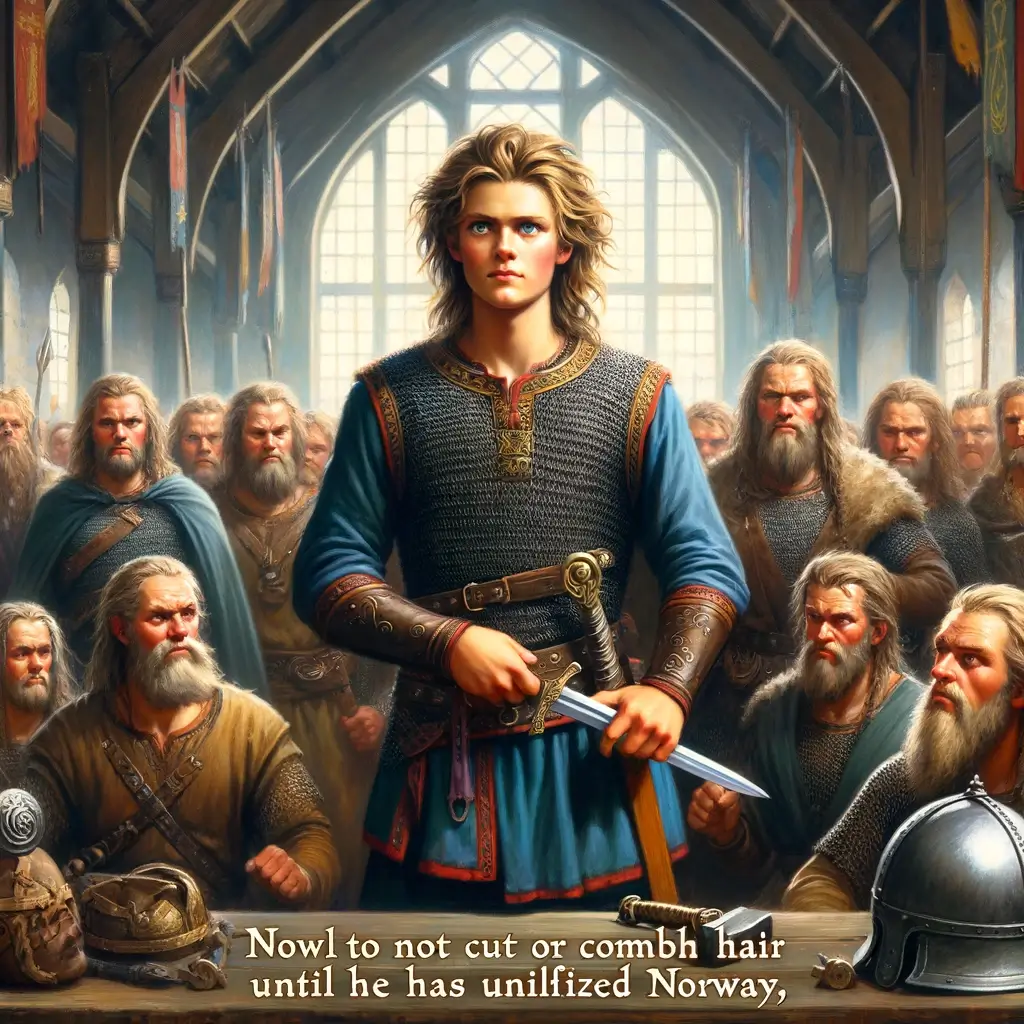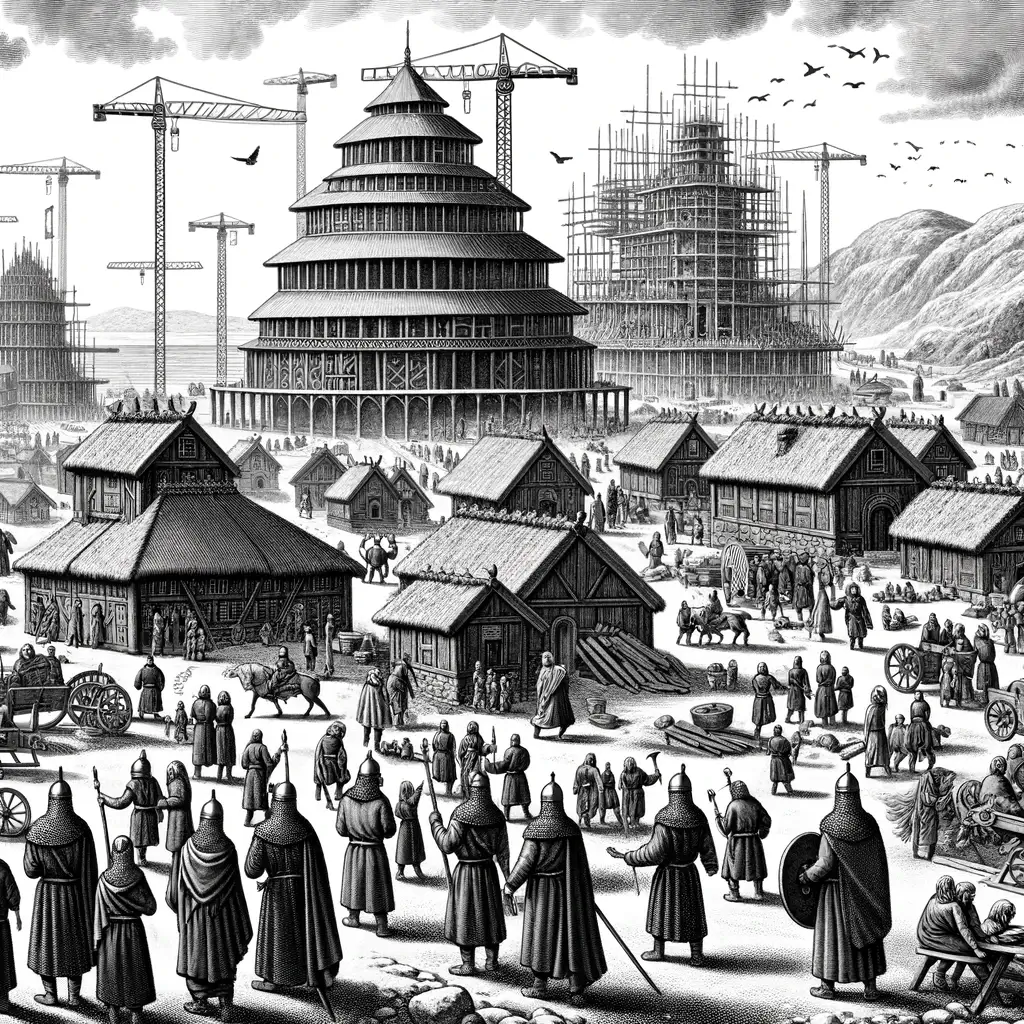Harald Fairhair stands as a towering figure in the annals of Norse history, celebrated both as a legendary hero and a pivotal architect in the unification of Norway. His saga, straddling the realms of history and mythology, chronicles the journey of a determined leader whose ambition and prowess forged a unified nation from a tapestry of warring factions. This article aims to delve into the depths of Harald’s life, his monumental achievements, and enduring legacy, offering a comprehensive, original, and factual exploration. By weaving together historical records and mythological narratives, we endeavor to present a vivid portrait of a ruler whose actions laid the foundations of modern Norway, ensuring our content’s originality, accuracy, and trustworthiness in portraying this seminal figure’s impact on history and culture.
| Attribute | Harald Fairhair Information |
|---|---|
| Origin | Norse History and Sagas |
| Historical Figure | First king of Norway |
| Unification | Known for unifying Norway under his rule |
| Battles | Famed for his military conquests and battles |
| Saga References | Mentioned in Norse sagas, particularly the “Heimskringla” |
| Cultural Impact | A significant figure in Norwegian history, symbolizing the unification of Norway |
| Legacy | Known as the founder of the Norwegian monarchy, paving the way for future rulers |
1. Historical Context
Landscape Before Harald Fairhair
Before the emergence of Harald Fairhair, Norway was not a unified nation but a patchwork of independent territories governed by local chieftains. These territories, known as petty kingdoms, were scattered across the rugged Norwegian landscape, from its deep fjords to its mountainous interiors. The social structure was predominantly tribal, with each region fiercely maintaining its autonomy and culture. The economy was based on agriculture, fishing, and raiding, with the latter becoming increasingly prominent as Viking expeditions grew in scope and ambition. This period, characterized by frequent skirmishes for control of land and resources, underscored a volatile and fragmented political landscape.

The Fragmented State of Norway in the Viking Age
During the Viking Age, Norway’s fragmented state was a significant obstacle to peace and prosperity. The lack of a central authority led to constant warfare among the petty kingdoms, with chieftains vying for dominance over their rivals. This period was marked by a warrior culture that valued honor, bravery, and feats of arms, further fueling the cycle of conflict and retribution. The disunity made it difficult to repel external threats and hindered the development of trade and infrastructure. It was against this backdrop of division and strife that Harald Fairhair’s ambitions to unify Norway would emerge as a transformative force, seeking to consolidate the myriad kingdoms under a single crown and create a stable, centralized state. This aim was not only driven by a desire for power but also by a vision of a united Norway, capable of standing strong against its enemies and flourishing as a cohesive society.
2. The Legend of Harald Fairhair
Harald’s Lineage, Birth, and Early Life
Harald Fairhair, or Harald Hårfagre in Norwegian, was born into a lineage steeped in the lore and leadership of the Norse. His father, Halfdan the Black, was a respected king who ruled over several small realms in southeastern Norway, laying the groundwork for Harald’s future ambitions. The historical records suggest that Harald was born around the mid-9th century, though precise dates vary among sources. His upbringing was marked by the traditional Norse virtues of bravery, wisdom, and the art of warfare, preparing him from a young age for the challenges of kingship.
The Vow and Its Impact
One of the most enduring tales about Harald Fairhair is his vow to not cut or comb his hair until he had unified Norway under his rule. This pledge was reportedly made to impress Gyda, a princess who refused his marriage proposal, stating she would only marry a king of all Norway, not just a fraction. This vow was not just a personal challenge but a public declaration of Harald’s ambition and determination. It symbolized his commitment to the monumental task of unification, rallying supporters to his cause and cementing his image as a leader of unwavering resolve.

This unorthodox approach to kingship, blending personal ambition with national unity, significantly impacted his leadership style and public perception. Harald’s unkempt appearance became a symbol of his dedication to Norway’s unification, distinguishing him from other rulers of his time. It was only after achieving his goal, following the decisive Battle of Hafrsfjord, that Harald was said to have finally cut and combed his hair, earning him the epithet “Fairhair.” This act not only marked the fulfillment of his vow but also the beginning of a new era for Norway, with Harald as its first unified king. The story, blending historical events with mythological embellishments, highlights the intertwining of personal and political narratives in the shaping of a nation’s identity.
3. Battles and Unification
Major Battles and Strategic Moves
Harald Fairhair’s path to unification was marked by a series of strategic battles and alliances that showcased his military acumen and diplomatic skill. Among the numerous skirmishes and conflicts, the Battle of Hafrsfjord stands out as the most significant. This battle, believed to have taken place around 872 AD, represented a turning point in Norwegian history. Harald faced a coalition of regional leaders resistant to his rule, and the victory at Hafrsfjord effectively marked the culmination of his efforts to unify Norway. This victory did not come easily; it was the result of careful planning, shrewd alliances, and the effective mobilization of forces.

Military Strategies and Leadership Skills
Harald’s military strategies were innovative and adaptive, combining traditional Norse warfare tactics with strategic diplomacy. He understood the importance of naval power in controlling Norway’s fragmented coastline and invested in building a strong fleet. Harald’s leadership during battles was characterized by his ability to inspire and lead from the front, a trait that earned him loyalty and respect among his warriors.
Another aspect of Harald’s strategy was his approach to alliances. He skillfully negotiated marriages and alliances with other chieftains, either through diplomacy or force, to consolidate his power. These alliances were crucial, as they not only expanded his influence but also ensured that his rule was accepted more widely across the territory.
4. Harald’s Reign and Governance
Establishing Central Administration
Following his unification of Norway, Harald Fairhair shifted his focus from conquest to governance, demonstrating an understanding that a unified kingdom required a strong, centralized administration to sustain its cohesion and prosperity. Harald’s governance model was pioneering for its time; he established a rudimentary form of central administration that sought to oversee the vast and diverse territories of Norway under a single crown. This system was instrumental in maintaining the peace and unity that Harald had fought so hard to achieve.
One of Harald’s notable administrative moves was the distribution of lands to his allies and loyal followers, a strategy that served multiple purposes. It rewarded loyalty, ensuring the continued support of key figures across the kingdom, and it helped to consolidate royal authority by placing trusted leaders in positions of power throughout the land. These lands were often governed as earldoms or smaller kingdoms under the overarching sovereignty of Harald, creating a feudal-like system that would influence Norwegian governance for generations.

Changes in Society and Culture
Under Harald’s reign, Norwegian society and culture began to undergo significant transformations. The centralization of power led to increased stability, which in turn fostered trade and cultural exchange both within Norway and with other regions. This era saw the growth of towns and the development of infrastructure, which further consolidated Harald’s control and facilitated the integration of the kingdom’s diverse regions.
Archaeological evidence from this period, such as the construction of large halls and fortifications, attests to the societal changes and the increasing complexity of social structures. The distribution of wealth and the emergence of a more defined class system are evident in burial sites, where the graves of the elite were marked by greater opulence.
Harald’s governance also had a lasting impact on Norwegian culture, particularly in the consolidation of Norse mythology and traditions. By unifying the country, Harald helped to standardize the oral traditions and practices, which would later be compiled into the sagas and eddas that are so crucial to our understanding of Norse culture. This period of stability allowed for the flourishing of arts and crafts, evident in the intricate metalwork and wood carving that have been uncovered from this era.
Harald Fairhair’s reign, therefore, was not just a milestone in terms of political unification but also a transformative era for Norwegian society and culture. His efforts to establish a centralized administration and distribute lands strategically laid the groundwork for the development of a coherent Norwegian identity. Through archaeological finds and historical records, we can trace the profound changes that took place during Harald’s rule, painting a picture of a ruler whose impact went far beyond the battlefield, shaping the very fabric of Norwegian society.
5. Harald Fairhair in Mythology and Culture
Portrayal in Norse Mythology and Sagas
Harald Fairhair’s legacy extends far beyond the historical records of his reign and into the realms of Norse mythology and saga literature, where he occupies a prominent place. In these narratives, Harald is often depicted as a larger-than-life figure, embodying the ideals of Norse heroism, leadership, and the pioneering spirit of the Viking Age. The sagas, particularly “Heimskringla” by Snorri Sturluson, offer rich descriptions of Harald’s exploits, his unification of Norway, and his governance, blending historical facts with mythological elements to create a compelling portrait of the king.
These sagas played a crucial role in shaping the image of Harald Fairhair for generations to come, presenting him as a cunning strategist, a fearless warrior, and a wise ruler. His vow to not cut or comb his hair until he had unified Norway is a recurring theme, highlighting his dedication and determination. Through such stories, Harald emerges not just as a historical figure but as a symbol of Norwegian unity and identity, revered for his contributions to the nation’s formation.

Representation in Later Cultural Works
Harald Fairhair’s influence extends into modern cultural works, including literature, film, and television, where he continues to be celebrated as a foundational figure in Norwegian history. His character has been reimagined in various forms, from the noble and just ruler to the ambitious conqueror, reflecting the complexity of his legacy.
Contemporary depictions often emphasize Harald’s role in the unification of Norway, exploring the challenges he faced and the impact of his reign on the shaping of Norse society. These portrayals contribute to the ongoing dialogue about Harald’s place in history, offering new interpretations and insights into his life and achievements.
In addition to fictional works, Harald Fairhair has also been commemorated in various forms of public memory, including statues, commemorative events, and educational materials. These acknowledgments serve to reinforce his status as a national hero and to educate future generations about his pivotal role in Norwegian history.
6. Conclusion
Harald Fairhair’s saga, from his ambitious vow to unify Norway to his transformative reign, encapsulates the essence of Norse valor, leadership, and the dawn of a unified nation. His strategic military campaigns, notably the pivotal Battle of Hafrsfjord, and his innovative governance laid the foundational stones of modern Norway, shaping its social and cultural landscape. Harald’s legacy, immortalized in sagas and mythology, continues to resonate, portraying him as a figure of national unity and cultural identity. Through historical records and mythological narratives, Harald Fairhair emerges as a seminal figure whose life and achievements mark a defining epoch in the annals of Norse history, embodying the spirit of an era that continues to captivate and inspire.
